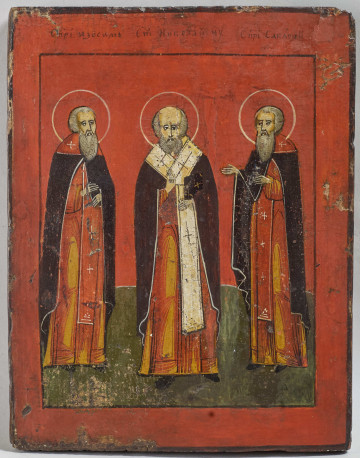
Saint Paraskevi
XIX/XX wiek
Castle Museum in Łańcut
Part of the collection: Ikony
Christ in the Tomb. Acre Tapeinosis
In Byzantium, relics were an important element in the formation of the artistic and symbolic sacred space of both the temple and the individual icon. Among the more important depictions of this type is the icon with the representation of the dead body of the Saviour in the Tomb (Akra Tapeinosis), shown as a bust or in half-length pose against the background of the cross, with marks on the body associated with the Passion. This representation has no equivalent in the Gospel texts. The earliest images originate from the early Byzantine tradition associated with the relic of the Shroud in which the Saviour's body was wrapped after death, and the Mandylion icon initially kept with other Passion relics in the sanctuary of the Church of the Virgin of the Pharos in the imperial district of Constantinople, and later in the Church of Saint Mary of Blachernae. According to accounts, every Friday the Shroud with the image of Christ's body on the linen (partially visible - bust or half-length) was fixed vertically to the cross and unrolled to show it to the worshippers. However, these relics were not made available for direct adoration and kissing of the believers; for this purpose, previously made small icons with the image of the dead body of Christ in the Tomb copied from existing relics were displayed. This marked the beginning of the iconography of depicting the Mystical Body of Christ. Icons of Christ in the Tomb were used in the rites of the Holy Week liturgy. It was the most appropriate depiction of the events of the Passion – the essence of its most important moments: Crucifixion (the cross behind the figure of Christ); the death of the Saviour - the dead Body of Christ in the Tomb; the Lamentation of Christ personified by the figure of the Mother of God holding up the Saviour. In the Ruthenian tradition, icons with Mary holding up the dead Christ are titled with the words of the canon "Weep Not For Me, O Mother" of the song of the Great Saturday celebration, composed by Cosmas of Maiuma in the eighth century.
Teresa Bagińska-Żurawska https://orcid.org/0000-0002-9243-3967
Author / creator
Object type
ikony
Technique
tempera, pozłotnictwo
Material
wood, chalk, distemper, silver, canvas
Creation time / dating
Creation / finding place
Owner
Muzeum - Zamek w Łańcucie
Identification number
Location / status

XIX/XX wiek
Castle Museum in Łańcut

20th century
Castle Museum in Łańcut

XIX century
Castle Museum in Łańcut
DISCOVER this TOPIC
National Museum in Szczecin
DISCOVER this PATH
Educational path